THERE’S something inherently joyful about Visithra Manikam as she walks into the cafe to meet me. A certain joie de vivre exudes from her that’s inexplicably infectious. “Hi, I’m Visithra,” she greets me warmly, extending her hand. A thick mane of curly hair frames her cherubic face, her nose ring glints in the afternoon light and her smile is wide.
A visual artist and photographer, Visithra looks every inch the bohemian virtuoso. Muted colours (her grey dress) sit well with the bold turquoise accents. A juxtaposition of flamboyance, shyness, confidence and a little reticence that she reveals, reflects her personality. I’m complicated, she declares unapologetically with a hearty laugh. Aren’t we all? A mix of emotions, shapes and colours. Like her artwork.
It’s impossible not to be moved by Visithra’s visceral paintings. Bold beautiful colours, the female form in all her glorious imperfections, all-seeing eyes and Indian symbolisms dominate her canvas. Dark-skinned goddesses smile benevolently, posturing Rubenesque figures displayed in glorious technicolour – bright, beautiful, whimsical, kitschy – and they all have a story to tell. “It’s a simple one really,” she explains blithely. “We’re all beautiful!”
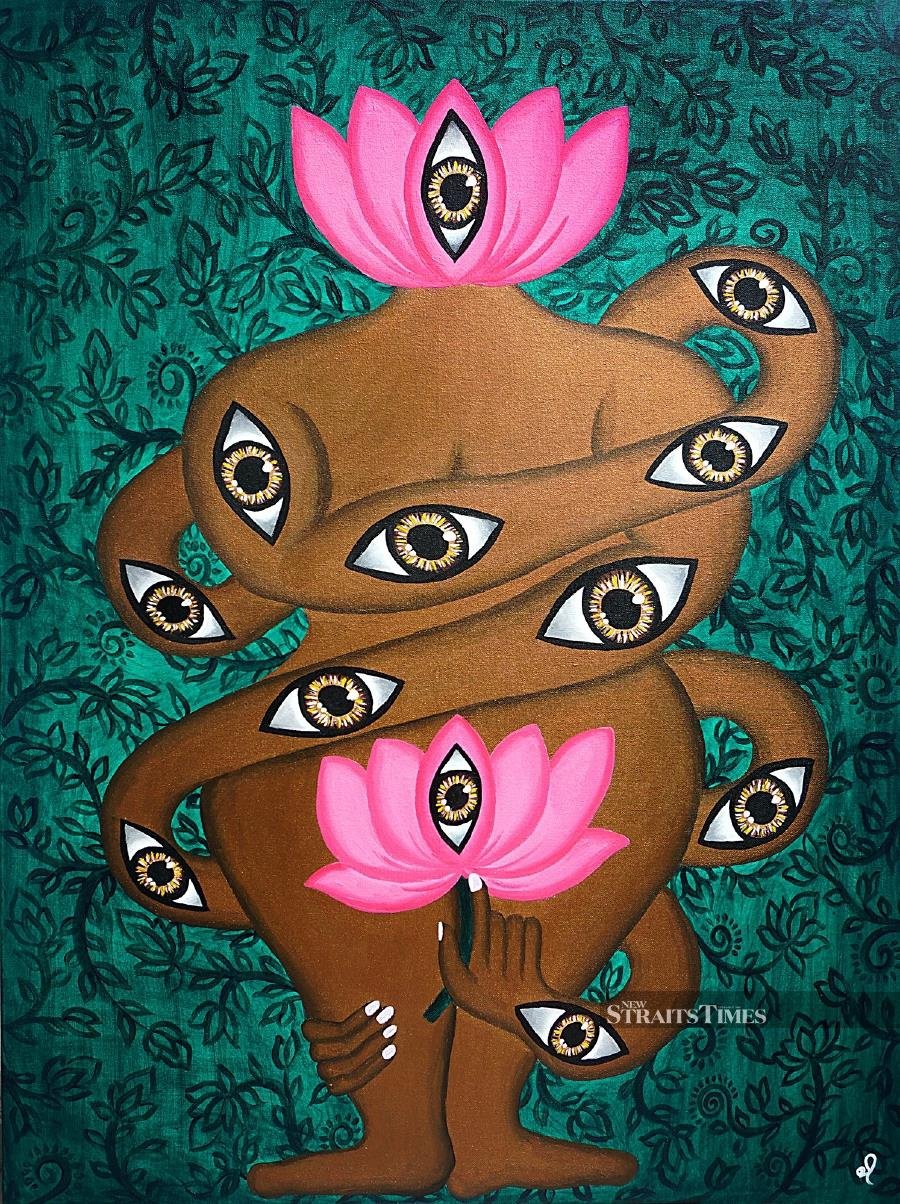
She sees all.
Rebelling against the beauty standards that demand women work hard for a mythical ideal body type and skin colour, Visithra’s figures are often drawn content with the present. “We’re worth all the love in the universe,” she emphasises, adding: “We’re beautiful in all our flaws and imperfections.” Pausing for effect, she asks exasperatedly: “Why can’t we be happy the way we are?”
The award-winning artist’s body of work was recently exhibited at the Ledge Gallery, Kuala Lumpur. But acrylic on canvas isn’t her only ‘weapon’ of choice. After all, she adds with a grin, she was crowned champion in a live doodle competition back in 2018.
There’s no stopping this late bloomer where painting is concerned. “I only took to painting a few years ago!” she confesses. Besides taking part in numerous exhibitions in Malaysia, Visithra has also exhibited her work in Manila, Philippines, 2018; Bangla Biennale, West Bengal, India and in Yogyakarta, Indonesia, early this year.
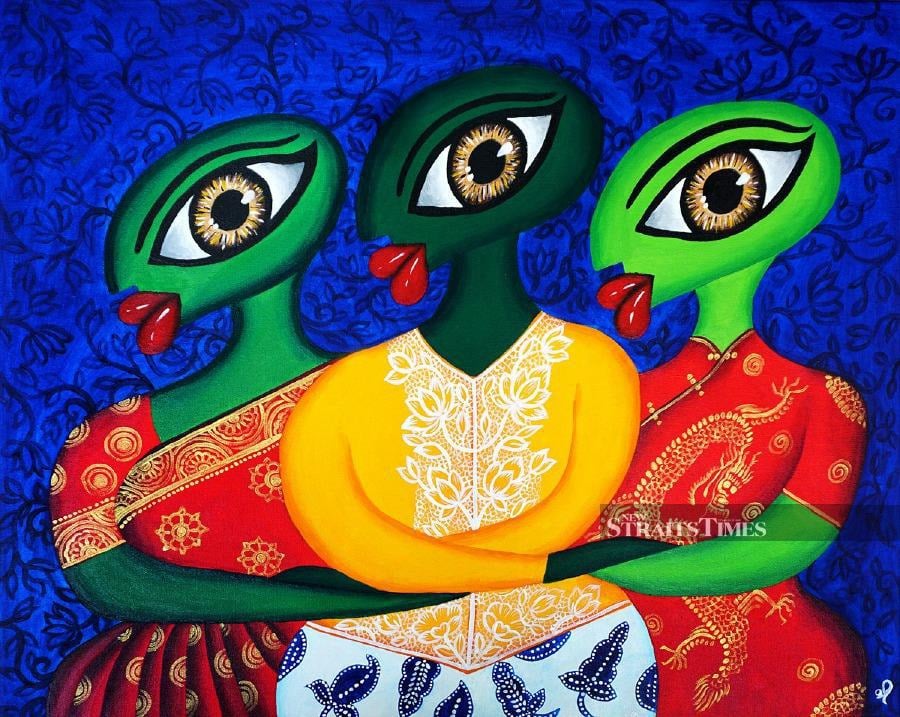
Our Malaysia.
Pop art, pop surrealism, “big eyes” art (in the style of the famed Margaret Keene) – Visithra’s art flits past many styles but the artist maintains that her messages and the stories she wants to tell through her work remains the same: acceptance. Her pieces magnify the raw details of embodied experience: large, drooping breasts; generous bellies and flab; scars and dark skin.
While painters throughout history – Peter Paul Rubens, Titian, Willem de Kooning, and Pablo Picasso – have long objectified the female body, the subject matter becomes potent under Visithra’s brush. If her oeuvre doesn’t quite offer a traditional pretty picture of humanity, she believes it’s an honest one. “But who’s to judge what’s beautiful and what isn’t?” she argues.
In a society obsessed with body image and marked by a fear of fat, Visithra engages in radical body politics through art. She confronts the public's perception of bigger bodies by bringing them into spaces that were once off limits – canvasses and art galleries — and entices all of us to look again and rethink our biases. "Unapologetic fat bodies can blow people's minds," she remarks, her eyes sparkling with mischief.
NEVER THE HEROINE
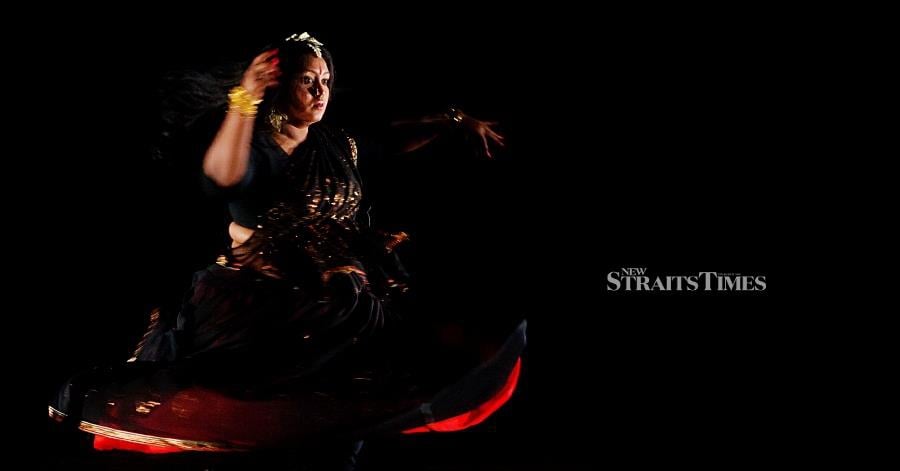
Visithra performing at KLPAC in 2011. Picture by Kong Dkbu.
“I’ve been big all my life,” she reveals candidly. “I struggled with accepting my body for the longest time.” When she was younger, people told her she’d be so pretty if only she could lose weight. “My father also had a problem with my weight, and that was hard,” she confesses softly. After a pause, she adds, chuckling: “My mother, on the other hand, gave me ‘Fair & Lovely’ cream which seems to be the go-to elixir for Indians to obtain fairer skin!”
Being overweight and dark, she insists, didn’t stop her from pursuing the things she loved.
“I was a Bharatanatyam dancer, I studied classical singing and I played the veena (a traditional Indian stringed instrument),” she recalls, telling me that she was always active as a child and loved dancing. “But I was a plump dancer!” she says drily. That meant she faced a certain amount of discrimination because of her size or colour. “They’d never put me on as a heroine. I was always either given the comic or the villain role. The assumption was that I wasn’t the right size or the right fit,” remarks Visithra, shrugging her shoulders.
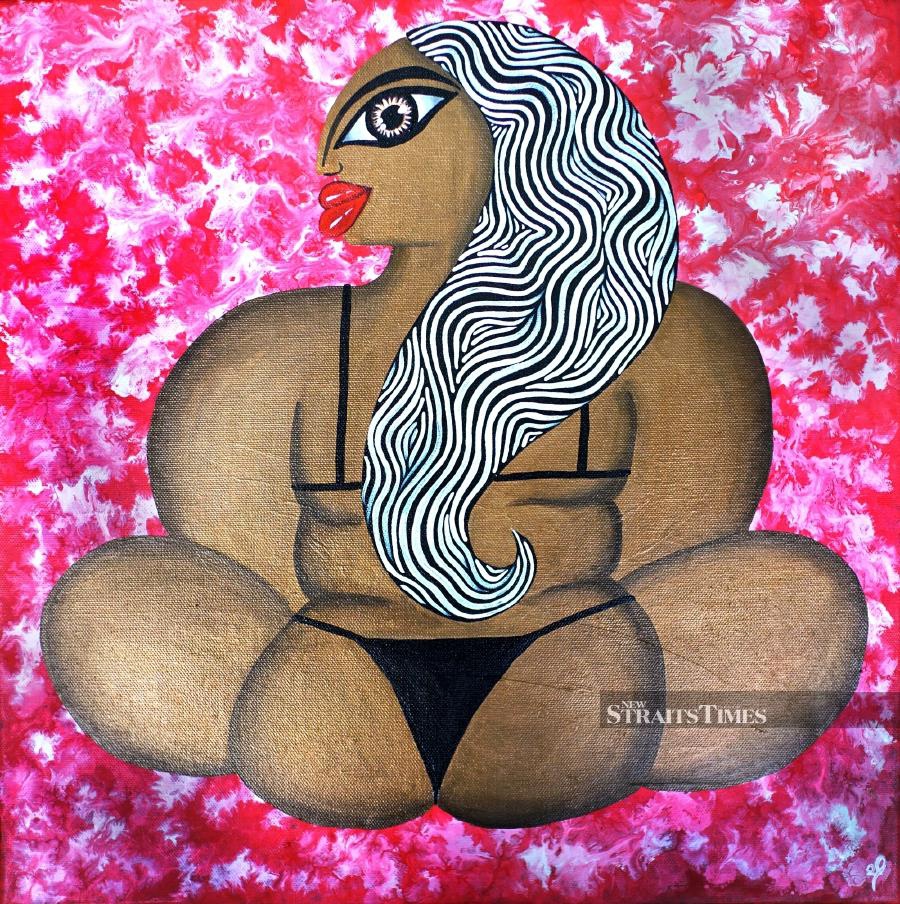
Bikini Body.
Of course, these thoughts eventually crystallised into confusion, questions. Why had she been blessed with these talents in this body? What does it mean when her body is her art? Can a thicker brush not make just as beautiful strokes? “I refused to let it stop me,” she asserts firmly. “I kept dancing anyway. I knew that people did enjoy seeing me dance!” She pauses and then adds on a cheeky aside: “… and I did enjoy playing the villain!”
Being “dark and fat” as Visithra bluntly puts it, meant that she faced discrimination and unwanted attention everywhere she turned. Even at the ATM, she recounts, she’d be stopped by strangers offering her unsolicited weight loss advice. Not too long ago, a waitress at a restaurant she was having a meal at, asked her how was she happy despite being fat. “I told her off,” she recalls waspishly. “It’s not okay to behave that way!” Visithra is not only unapologetic about her body, she’s proud of it. Her confidence has catapulted her to creating a platform that she hopes would spark a dialogue about acceptance and body positivity.
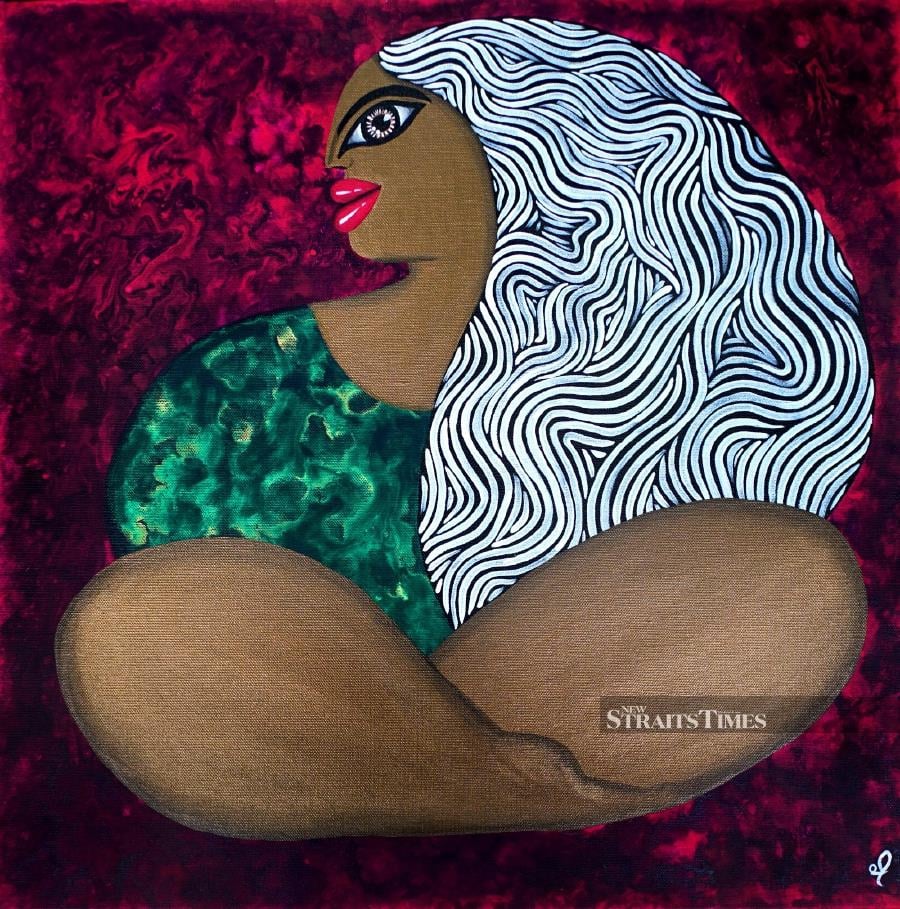
Fat and happy.
“Fat is still associated with ugly,” she continues. “It’s very easy to say we shouldn’t concentrate on our bodies. But for some of us we have no choice because everyone else is. Growing up, there weren’t fat dark black people on film, you never saw them being the object of desire, or playing the lead role. There still aren’t.”
This has led her into bringing these messages into her art. “You don’t find fat or dark people being represented often in the art sphere either,” she remarks bluntly, adding: “Art has a way of forming, shaping and holding in front of your eyes something you feel internally. It’s about storytelling and helping people develop a narrative of their lives and relate to their own experience in a new way.” Telling a story, she explains, helps people view things differently. “Art can do just that,” she says.
For the artist, body positivity is more than weight acceptance. It’s about accepting one’s body as it is, regardless of what’s deemed socially acceptable or beautiful: from the external like acne, body hair, cellulite and stretch marks, to the more complex like physical disabilities or disorders. “That’s why I put curves in my art. I put scars on them. Imperfections need to be shown and celebrated!” she exclaims, smiling.
HER FATHER’S DAUGHTER
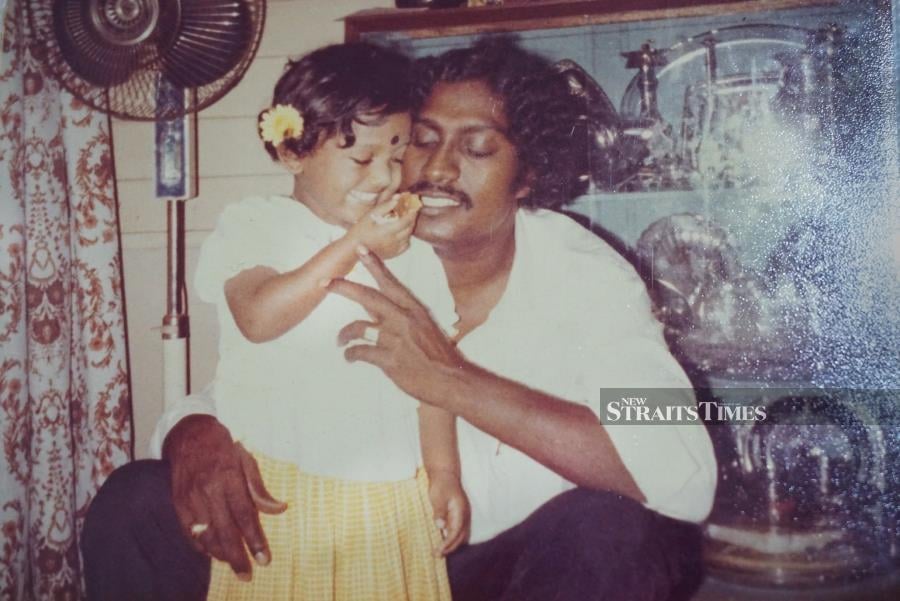
Visithra and her late father.
Much of her determination and fortitude, she confides, comes from her late father. “My sense of social justice and speaking out against injustice comes from him.” Her relationship with her father was tumultuous, she admits. “We were too much alike – opinionated and headstrong!” Their relationship took a turn for the better, the year before he passed. “I think in some way he realised he didn’t have too long to live and wanted to build his relationship with me,” she says softly. Her father passed away when Visithra was just 23, leaving her to be the sole breadwinner for her mother, a housewife and her younger brother. “It wasn’t easy, but we got by,” she says quietly, of that time.
Her father was involved in politics at one point, “…but he left the field because he was too honest for politics!” she says, before adding cheekily: “I’ve inherited his courage, I guess!” However, that isn’t the only trait Visithra inherited.
His love for photography was another legacy left behind for his eldest daughter. “My father rarely appeared in family photographs because he was the one behind the camera,” she recalls. “Eventually when I grew old enough, we’d take turns handling the camera!”

Visithra's photograph capturing the Ganesha Chaturthi festival in Mumbai.
The 39-year-old enjoys photography tremendously. “I love street photography and capturing people,” she shares. It’s a way of connecting back with her late father, she muses. “It was him who instilled my love for photography. I guess this is my way of honouring his memory.”
Painting she admits, was something she ventured into, not too long ago. “I grew up drawing kolams (geometrical drawings traditionally done on the floor using rice flour) but I only went into painting because I was bored!” she recalls, chuckling.
When she started painting, she couldn’t stop. “It was as if a dam had burst,” she recalls, her eyes shining. The self-taught photographer and artist was determined to hone her skills. “I love learning new things and I don’t do it by halves,” she says with a determined tilt to her chin. Another one of her father’s traits? I tease. “Perhaps!” she responds, chuckling.
Her name, she tells me gleefully, means “extraordinary ruby”. “My father gave me the name. But I think he named me hoping I’d turn out to be a doctor!” she divulges with a laugh. “You know lah… Indian family!” she jokes, chuckling. Her parents, she says, were extremely supportive of her interests and many artistic pursuits. “They’d attend every single dance recital!” she shares, adding with a smile: “My mother continues to support and indulge my whims!”

She.
She regales me with a story of how she bought a piece of art that was considered quite morbid. Her mother didn’t blink an eye. Instead, she just remarked drily: “Just don’t hang it in the hall!” Her mother, she says with a hearty laugh, is used to her rather eclectic and “strange” taste in art.
She remains close to her mother but the tenuous bond between father and daughter was undeniable, she says, despite the fact that he was the ‘typical Asian father’ who didn’t show his affections outwardly. “I’m very much like him in many ways,” she shares. “From the way I feel about social injustice right down to the way I drive! He used to complain to my mother that I drove just like him… one hand on the steering wheel!”
Opinionated and passionate, the Public Relations executive vows to keep speaking and trying to change the judgemental narratives surrounding women and their bodies. “I learnt to stop believing in the opinions of others,” she confides, adding: “No one has taught us to accept ourselves the way we are. That’s got to change.”

Earth goddess.
And that’s exactly what she’s doing with her art. Curves, generous flesh, scars and dark-skinned women abound in her art. Believing wholeheartedly in the healing power of creative expression, Visithra’s work explores identity, personal histories and the experiences of dark-skinned big women.
She aims to create the space for play, self-reflection, self-awareness, empowerment and healing.
“I’ve received messages from women who found inspiration in my art,” she reveals, adding: “And that’s why I do what I do. It isn’t enough to be confident in your own skin. You need to extend that gift to others so that they can learn to celebrate and accept themselves for who they are.”
Your parents must be so proud, I say. She looks at me quizzically before responding: “It’s not about seeking their approval.” A brief pause, she continues candidly: “I know they’re proud of me. My mum, especially, and my father would have been too. But above that, I’m proud of me. I’m Visithra. I’m fat and beautiful. It’s okay if you don’t think that I am. I know I am and it’s enough. That’s liberating to me and I’m happy.”
And the joy I feel radiating from her is palpable.
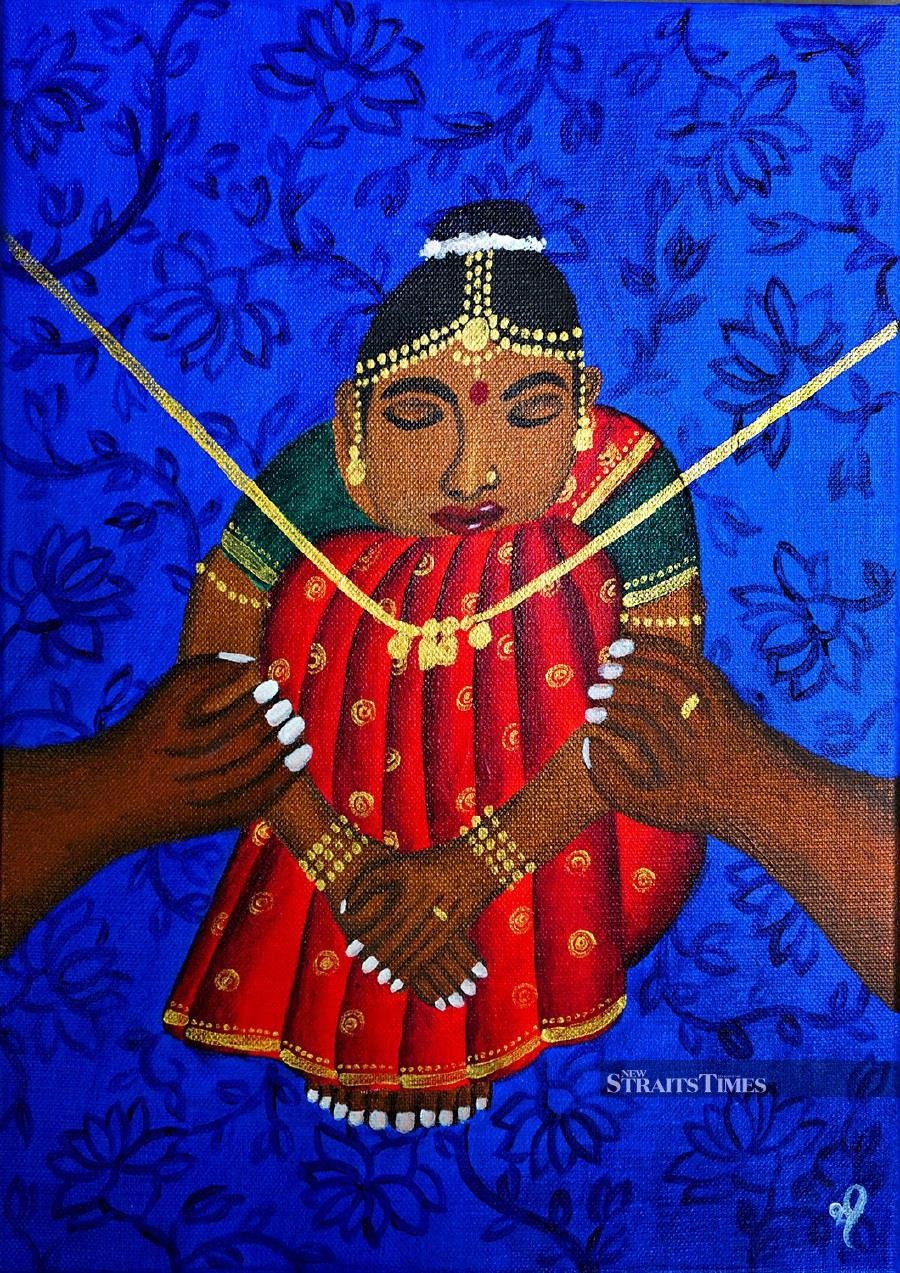
Girls not brides.
For further details on Visithra and her art, please go to www.facebook.com/vissyarts


